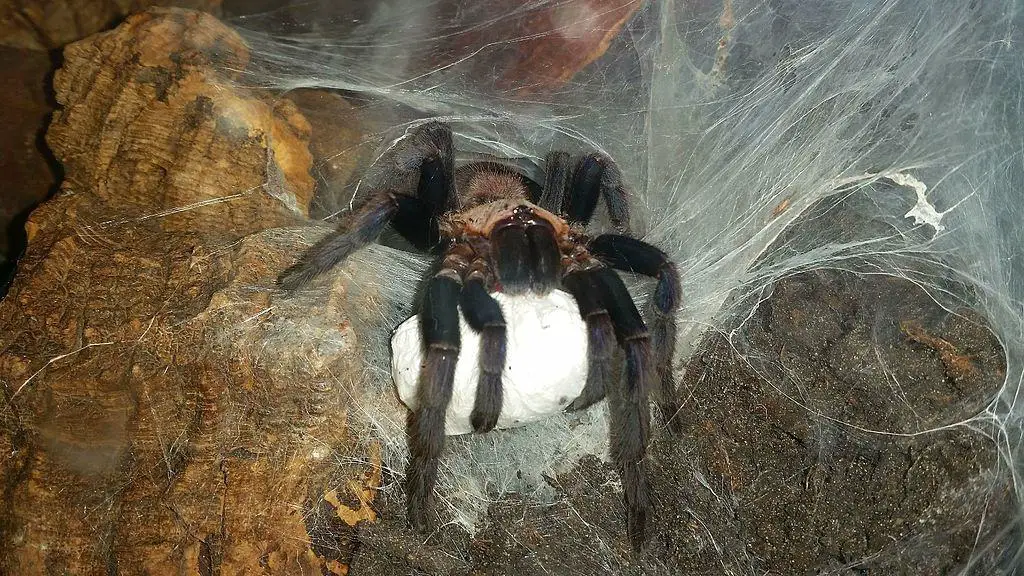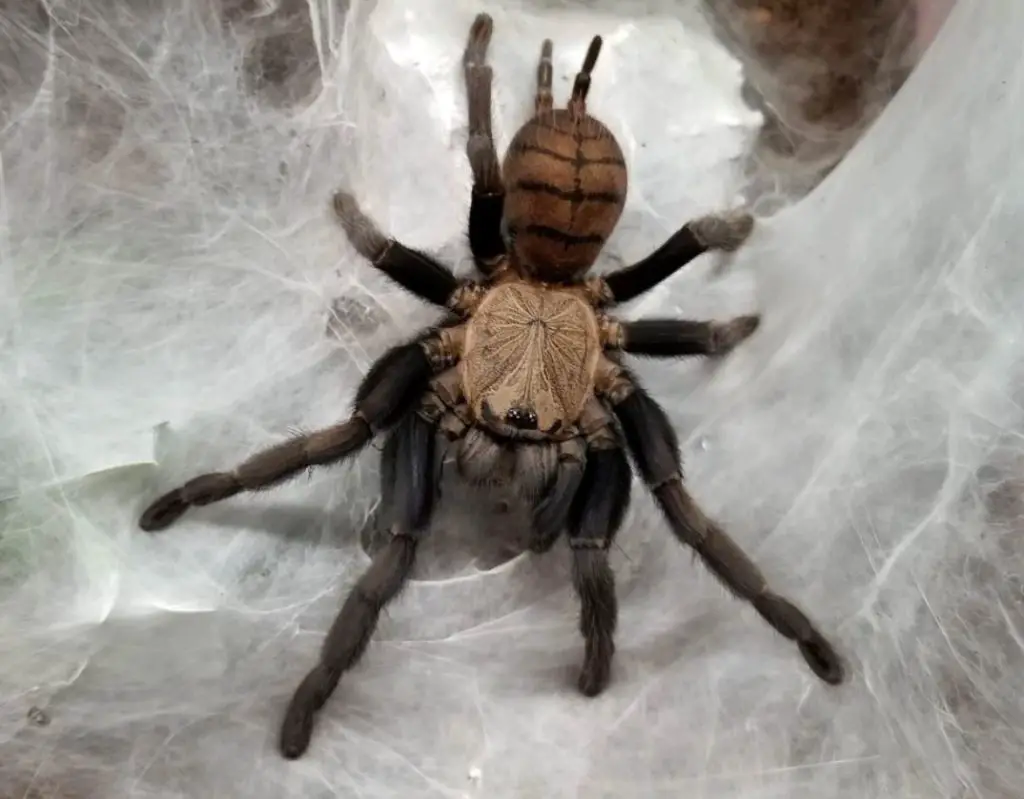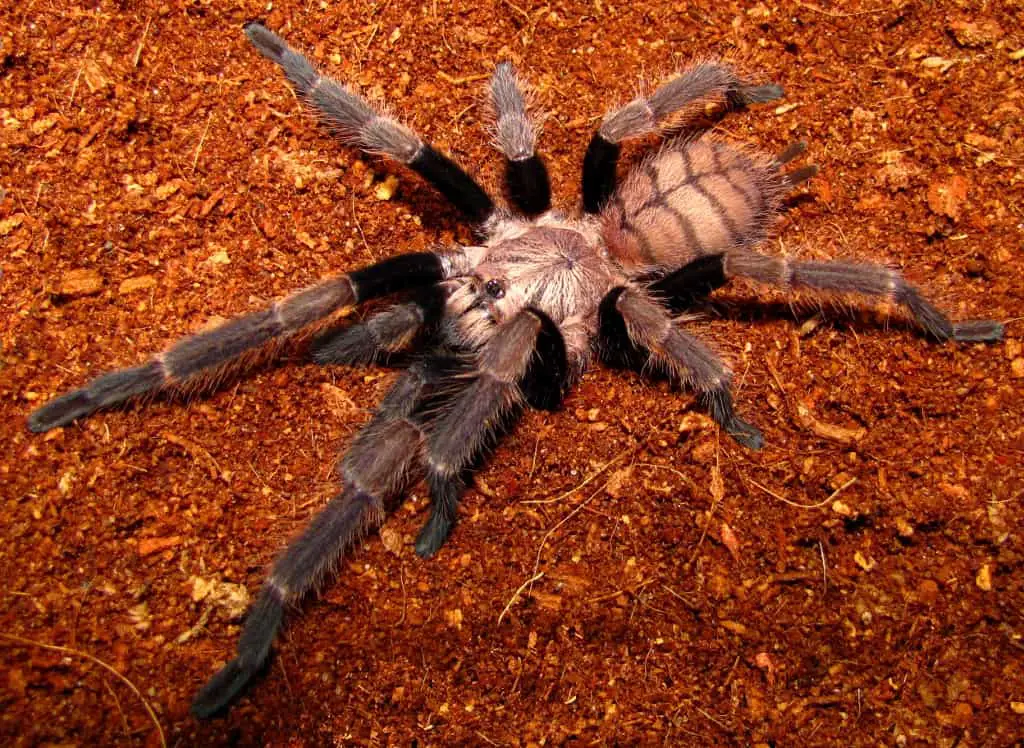The Indian Violet Tarantula (Chilobrachys fimbriatus) is an Old World terrestrial species and is said to be the most beautiful of the Chilobrachys genus.
Native to India, this spider has a defensive temperament and potent venom, which can make them hard to care for. Nevertheless, their beautiful appearance has made them one of the favorites amongst intermediate and advanced keepers.
Known for its characteristic patterns, temper, and proficient webbing, here’s all that you need to know if you’re looking to maintain one of these beautiful arachnids under your care.
Indian Violet Tarantula Care Sheet
| Species Name | Chilobrachys fimbriatus |
| Family Name | Theraphosidae |
| Common Names | Indian Violet, Earth Tiger |
| Category | Old World |
| Type | Terrestrial burrower |
| Native Location | India |
| Body length | 2.5 inches (7 cm) |
| Leg Span | 6 inches (15 cm) |
| Growth Speed | Fast |
| Urticating Hairs | No |
| Social | Solitary |
| Diet | Crickets, roaches, mealworms |
| Temperature | 78 to 82 degrees Fahrenheit |
| Humidity | 70% |
| Lifespan | Female: 20 years / Male: 2 to 4 years |
| Experience required | Intermediate – Expert |
| Minimum tank size | At least 4x leg span in vertical space |
Indian Violet Tarantula Overview
The Chilobrachys fimbriatus, commonly known as the Indian Violet Tarantula (IVT) or the Violet Earth Tiger, is a burrowing bird spider.
In nature, it’s mainly found in India. Since it’s a member of the Chilobrachys and an Old World species, the Indian Violet Tarantula is famous for its rapid growth rate, defensive behavior, and voracious appetite.
This type of behavior, plus their fast movements and venom potency, is why it’s considered a risky choice for beginners. Handling this spider must be reserved for the most experienced keepers.
Appearance

The Indian Violet Tarantula is often described as the most gorgeous tarantula from the Chilobrachys genus.
Her femurs are dark violet turning into light brown as they go downwards. She exhibits a copper-toned abdomen with dark purple stripes mixing perfectly with her legs.
This species exhibits sexual dimorphism. The males are smaller, and their femur coloration is more black than violet once they mature.
Now, females tend to be more violet depending on the light’s angle. However, these differences are too subtle, so it’s hard to tell one apart from another just by looks.
The only way to safely identify whether you have a male or female Indian Violet Tarantula is to examine the inside of a molt.
Price
The cost of buying an Indian Violet Tarantula depends on whether you buy a female or a male.
Since they’re such fast growers, their prices don’t rise as high as some other species.
An unsexed or adult male can be bought for as little as $35.
On the other hand, due to their longevity, females can cost between $87 and $100 depending on the market.
Behavior and Temperament
The Indian Violet Tarantula is considered nervous, fast, and defensive. On top of that, she has a very potent venom.
Therefore, even though there are no fatal tarantula bites on humans, it’s still important to be careful not to get bitten to avoid uncomfortable and painful symptoms.
The Indian Volet Tarantula will try to flee at first glance of a possible threat, but persistent provocation can result in a threat posture and eventually a bite.
Depending on the location of the bite, and the amount of venom released, victims can develop quite severe symptoms. These symptoms are likely to last days or even weeks without proper care.
This spider is known for creating beautiful webs and a tunnel system below the surface. At broad daylight, she’ll stay deep inside her burrow. However, she’ll move to the entrance and wait for prey during the night.
They’ll spend more time out in the open as they grow older.
This species’ fast, defensive nature and potent venom mean that they’re not suitable for beginners to the hobby and should not be handled.
Caring for an Indian Violet Tarantula

Tarantulas are the ultimate low-maintenance pets. If you provide them with a tank that has good humidity and temperature, proper substrate, and good food, they’ll be able to thrive.
Let’s take a closer look at what exactly it is they need.
Temperature and Humidity
The Indian Violet Tarantula lives around tropical areas that have a monsoon period.
Temperatures in her natural habitat often reach 86°F.
They protect themselves against the sun by making a burrow deep in the ground. The most efficient temperatures in captivity should be around 78°F to 82°F with the humidity being around 70%.
Substrate
The Indian Violet Tarantula is an obligate borrower, which means that they need enough substrate to burrow into.
Spiderlings need at least four inches of substrate, while juveniles and adults should have six inches of substrate as a minimum.
As for the substrate composition, it can be a mixture of peat moss, vermiculite, and coconut fiber. You can add dirt for firmness; just make sure it’s soft enough for the spider to burrow into.
Tank
Adults should be kept in 10″x10″x20″ (25x25x50 cm) enclosures. Horizontal space is more important for this species than vertical space because they’re terrestrial.
As long as the tank is tall enough to place six inches of substrate into it with some space left over, it will be tall enough for them.
Another benefit of them having a tank that’s not too tall is that as a terrestrial species it’s not safe for them to fall from high places, or else they may be severely injured.
You do not need to provide this species with a hide; it will make its own burrow.
However, she does enjoy webbing, so you should add a few decorations to be used as a structure to help them make their webs.
Watering
The Indian Violet Tarantula is used to dry places. Therefore, watering it is pretty easy. You can use a water dish and refill it as soon as it gets empty. As for the substrate’s humidity, spray it every three to four months and let it dry out.
Smaller specimens should receive a misting with lukewarm water every once in a while so they can drink the droplets.
Try to direct the spray at the web and the sides of the cage. Prevent it from making contact with the spider itself.
Social
The Indian Violet Tarantula is definitely not a social species. They can not be housed communally and should always be kept solitarily.
Communal housing will result in cannibalism.
Molting
As a fast-growing species, the Indian Violet Tarantula will molt frequently. If you see that the spider has covered the entrance to its burrow with heavy webbing, then it’s likely going to molt. When this happens, stop feeding them as they will refuse to eat.
Molting is a stressful time for any tarantula and it’s important that you do not disturb them at this vulnerable time. Touching or interacting with them in other ways can lead to a failed molt which can result in your spider losing limbs.
After the molting process, you should avoid feeding them because they need time for their fangs to harden before they can use them.
Diet and Feeding
The Indian Violet Tarantula will aggressively take down even relatively large insects. Hobbyists can drop the prey on the outskirts of its webbing, which will bring the spider out in the open to grab its meal.
Even if she can take larger prey, it’s still enough to use crickets and roaches to feed them.
Spiderlings should get a flightless fruit fly twice a week. Juveniles should be fed one or two small crickets weekly. Make sure you check after feeding them to remove any uneaten food they may have left.
Adults should be fed a large roach or seven adult crickets every week.
Lifespan & Health
The Indian Violet Tarantula has quite a long lifespan. Males do not live very long at 2 to 4 years, but females can live for up to 20 years!
In captivity, they can easily live their full lifespan as long as you prevent mold, bacterial growth, spider mites, parasites, and falls.
Preventing falls can be done by making sure that their enclosure is not too tall so that if they do climb and fall it will not be from such a large height. Also, you can prevent falls by not handling them.
Mold, bacterial growth, and spider mites can be prevented by keeping their enclosure clean. Remove uneaten food in a timely matter and keep their water fresh.
Parasites can be prevented by not feeding your spider wild-caught insects.
Quick Facts About the Indian Violet Tarantula
- First described by Pocock in 1899, the phenotype was reportedly from the area around Khamala.
- This species’ population has been decreasing because of the activity of poachers smuggling it to America and Europe. This is because it’s considered the most beautiful of the Chilobrachys-genus. Don’t buy from poachers, only buy captive-bred spiders!
- In some cases, the Chilobrachys fimbriatus shares its habitat with Thrigmopoeus truculentus.
- Due to its abdominal stripe pattern, it’s also known as “Violet Earth Tiger.”
Final words: Is the Indian Violet the right tarantula for you?
The Indian Violet Tarantula is a stunning spider popular amongst experienced hobbyists. Make sure you get it from reputable vendors to know you’re buying a captivity-bred specimen to avoid supporting poachers.
For beginners, this spider’s defensive nature and potent venom do not make them very suitable. If you’re new to tarantula keeping, consider species such as the Arizona Blonde, Mexican Red Rump, or the Greenbottle Blue instead.
We hope this article provided you with all the information you need to make the right choice on whether you want to add this gorgeous spider to your collection.
- How Long Do American Eskimo Dogs Live? Important Factors and Care Tips - September 29, 2023
- Do American Bulldogs Need Grooming? Essential Tips and Care Guidelines - September 29, 2023
- Do Bengal Cats Enjoy Playing? Essential Tips for Keeping Them Active - September 29, 2023
